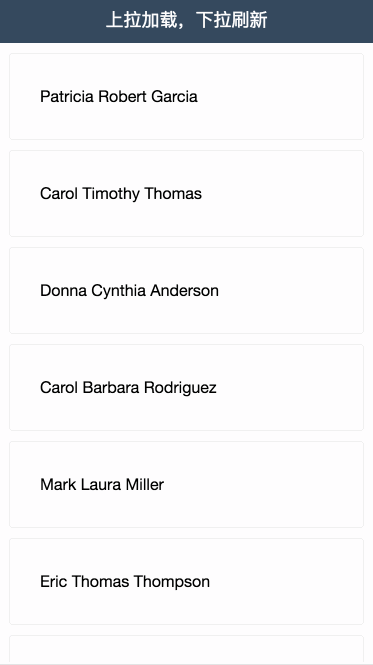
This article mainly introduces you to the relevant information about vue.js integrating pull-up, load, and pull-down refresh in vux. The article introduces it in detail through sample code. It has certain reference learning value for everyone's study or work. It needs Friends, let’s study together.
Preface
Vux is a mobile page UI component library developed based on Vue and Weui. The original development intention is to meet the company's WeChat form requirements. , because the third-party questionnaire form system is really ugly on mobile phones (the PC style is just adapted to the size). So I rebuilt the form component using vue, and then I got out of hand and developed other commonly used components as well.
I still prefer Vue to React. In addition to the fact that there are not many community components at present, the surrounding construction tools are relatively complete (the author is also very diligent).
Not much to say below, let’s take a look at the detailed introduction.
First picture

##Create project
Use vue-cli to create a vue projectInstall vux, you can refer to: vux quick startConfiguration
Official document addressAfter opening it, you will see a paragraphThis component is no longer maintained and is not recommended for use. In most cases, there is no need to use this component. It is recommended to use third-party related components, and related issues will not be handled. I don’t know why the author doesn’t maintain it. There is obviously a lot of demand.I didn’t use the LoadMore component in the demo. I used the use-pullup and use-pulldown that come with Scroller. The following is my configuration<!--
height: 我用到x-header了,文档里说header高是48px,所以这里设置成-48
-->
<scroller use-pullup :pullup-config="pullupDefaultConfig" @on-pullup-loading="loadMore"
use-pulldown :pulldown-config="pulldownDefaultConfig" @on-pulldown-loading="refresh"
lock-x ref="scrollerBottom" height="-48">
</scroller>
<script>
import {Scroller, XHeader} from 'vux'
const pulldownDefaultConfig = {
content: '下拉刷新',
height: 40,
autoRefresh: false,
downContent: '下拉刷新',
upContent: '释放后刷新',
loadingContent: '正在刷新...',
clsPrefix: 'xs-plugin-pulldown-'
}
const pullupDefaultConfig = {
content: '上拉加载更多',
pullUpHeight: 60,
height: 40,
autoRefresh: false,
downContent: '释放后加载',
upContent: '上拉加载更多',
loadingContent: '加载中...',
clsPrefix: 'xs-plugin-pullup-'
}
export default {
components: {
XHeader,
Scroller
},
mounted() {
this.$nextTick(() => {
this.$refs.scrollerBottom.reset({top: 0})
})
},
data() {
return {
list: [],
pullupDefaultConfig: pullupDefaultConfig,
pulldownDefaultConfig: pulldownDefaultConfig
}
},
methods: {
refresh() {
},
loadMore() {
}
}
}
</script>Request interface traversal data
The interface service uses the data generated by mock.js, you can take a look at this Article: Using mock.js random data and using express to output json interfaceInstall axios
yarn add axios
//...
methods: {
fetchData(cb) {
axios.get('http://localhost:3000/').then(response => {
this.$nextTick(() => {
this.$refs.scrollerBottom.reset()
})
cb(response.data)
})
}
}
//...//...
methods: {
refresh() {
this.fetchData(data => {
this.list = data.list
this.$refs.scrollerBottom.enablePullup()
this.$refs.scrollerBottom.donePulldown()
})
},
loadMore() {
this.fetchData(data => {
if (this.list.length >= 10) {
this.$refs.scrollerBottom.disablePullup()
}
this.list = this.list.concat(data.list)
this.$refs.scrollerBottom.donePullup()
})
}
}
//...//...
mounted() {
this.$nextTick(() => {
this.$refs.scrollerBottom.reset({top: 0})
})
this.loadMore()
}
//...<scroller> <p style="padding: 10px 0"> <p class="box" v-for="(item, index) in list" :key="index"> <p class="list"></p> </p> </p> </scroller>
The complete code
<template>
<p>
<x-header :left-options="{'showBack': false}">上拉加载,下拉刷新</x-header>
<scroller use-pullup :pullup-config="pullupDefaultConfig" @on-pullup-loading="loadMore"
use-pulldown :pulldown-config="pulldownDefaultConfig" @on-pulldown-loading="refresh"
lock-x ref="scrollerBottom" height="-48">
<p style="padding: 10px 0">
<p class="box" v-for="(item, index) in list" :key="index">
<p class="list"></p>
</p>
</p>
</scroller>
</p>
</template>
<script>
import {Scroller, XHeader} from 'vux'
import axios from 'axios'
const pulldownDefaultConfig = {
content: '下拉刷新',
height: 40,
autoRefresh: false,
downContent: '下拉刷新',
upContent: '释放后刷新',
loadingContent: '正在刷新...',
clsPrefix: 'xs-plugin-pulldown-'
}
const pullupDefaultConfig = {
content: '上拉加载更多',
pullUpHeight: 60,
height: 40,
autoRefresh: false,
downContent: '释放后加载',
upContent: '上拉加载更多',
loadingContent: '加载中...',
clsPrefix: 'xs-plugin-pullup-'
}
export default {
components: {
XHeader,
Scroller
},
mounted() {
this.$nextTick(() => {
this.$refs.scrollerBottom.reset({top: 0})
})
this.loadMore()
},
data() {
return {
list: [],
pullupDefaultConfig: pullupDefaultConfig,
pulldownDefaultConfig: pulldownDefaultConfig
}
},
methods: {
fetchData(cb) {
axios.get('http://localhost:3000/').then(response => {
this.$nextTick(() => {
this.$refs.scrollerBottom.reset()
})
cb(response.data)
})
},
refresh() {
this.fetchData(data => {
this.list = data.list
this.$refs.scrollerBottom.enablePullup()
this.$refs.scrollerBottom.donePulldown()
})
},
loadMore() {
this.fetchData(data => {
if (this.list.length >= 10) {
this.$refs.scrollerBottom.disablePullup()
}
this.list = this.list.concat(data.list)
this.$refs.scrollerBottom.donePullup()
})
}
}
}
</script>
<style lang="less">
.box {
padding: 5px 10px 5px 10px;
&:first-child {
padding: 0 10px 5px 10px;
}
&:last-child {
padding: 5px 10px 0 10px;
}
}
.list {
background-color: #fff;
border-radius: 4px;
border: 1px solid #f0f0f0;
padding: 30px;
}
.xs-plugin-pulldown-container {
line-height: 40px;
}
.xs-plugin-pullup-container {
line-height: 40px;
}
</style>How to use node.js and other technologies to implement the login and registration function?
How to use filter filter in vue
Gzip compression problem in HTTP
Issues related to text avoidance in front-end algorithms (detailed tutorial)
The above is the detailed content of How to integrate vux in vue.js to implement pull-up loading and pull-down refresh. For more information, please follow other related articles on the PHP Chinese website!




